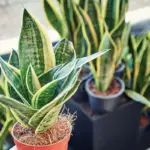Snake plants are a popular choice for indoor gardening due to their hardiness and striking appearance. However, before purchasing a snake plant, it is important to know how tall it can grow.
The height of a snake plant can vary depending on the species, with some reaching a maximum height of 3-4 feet, while others may only top out at 10-12 inches.
According to Simplify Gardening, the growth rate of snake plants is approximately 2 inches per year.
Some Sansevieria varieties can grow up to 8-10 feet tall, but these are rarer and more expensive.
In general, snake plants grow at a slow to moderate rate and prefer well-draining potting soil that is slightly acidic.
It is important to choose the right type of snake plant for your space, as some varieties may quickly outgrow their surroundings.

Table of Contents
Understanding Snake Plants
Snake plants, also known as Sansevieria, are popular houseplants because of their unique appearance and easy maintenance.
These plants are native to tropical regions of West Africa and are known for their long, upright leaves that resemble snake skin.
Snake plants come in a variety of sizes, from small tabletop plants to large floor plants that can grow up to several feet tall.
The height of a snake plant depends on the species and growing conditions. Dwarf snake plants, for example, will only grow to be around 10 to 12 inches tall, while other varieties can grow up to 8-10 feet tall.
One of the reasons snake plants are so popular is because they are low-maintenance and can survive in a range of growing conditions.
They are tolerant of low light and infrequent watering, making them a great choice for beginners or those who don’t have a lot of time to care for their plants.
In addition to their unique appearance and easy maintenance, snake plants are also known for their air-purifying properties.
They are able to remove toxins such as formaldehyde and benzene from the air, making them a great choice for indoor spaces.
Overall, snake plants are a great choice for anyone looking for a low-maintenance houseplant that can add a unique touch to their home decor.
With proper care, these plants can thrive for years and continue to provide their air-purifying benefits.
Typical Growth Patterns of Snake Plants
Snake plants are known for their hardiness and ability to thrive in various conditions. They are also popular for their unique and attractive foliage.
The height of snake plants varies depending on the species and growing conditions.
According to Simplify Gardening, most snake plant varieties reach a maximum height of 3-4 feet with a growth rate of approximately 2 inches per year. However, some rarer and more expensive Sansevieria varieties can grow up to 8-10 feet tall.
The Dwarf Snake Plant varieties, on the other hand, will only reach a height of around 10 to 12 inches. These shorter varieties are perfect for small spaces or as a tabletop decoration.
Another popular snake plant variety is the Mother-in-Law’s Tongue, which can exceed 6 feet in height, according to The Healthy Houseplant.
This variety is technically Dracaena trifasciata, which looks like the Laurentii without the golden bands at the edges.
In general, snake plants are slow-growing, but they can thrive in low light and neglect. The growth rate also depends on the growing conditions, such as the amount of light, water, and soil quality.
Snake plants prefer well-draining soil and do not like to be overwatered.
Overall, snake plants are a great choice for both beginner and experienced gardeners. They are easy to care for, have a unique appearance, and can add a touch of green to any space.
Factors Influencing the Height of Snake Plants
Snake plants are known for their easy maintenance and hardiness.
They can tolerate a wide range of conditions, which makes them a popular choice for indoor and outdoor gardening. However, the height of your snake plant can be influenced by several factors.
Understanding these factors can help you create an ideal environment for your snake plant to thrive.
Pot Size
The size of the pot can affect the height of your snake plant. If the pot is too small, it can restrict the growth of the roots, which can lead to stunted growth.
On the other hand, if the pot is too large, the soil may stay too wet, which can lead to root rot. A pot that is slightly larger than the root ball of the plant is ideal.
This allows for some room for the roots to grow, but not too much that it becomes waterlogged.
Light Exposure
Snake plants can tolerate low light conditions, but they also require some amount of light to grow. If your snake plant is not receiving enough light, it may not grow as tall as it could.
On the other hand, if it is receiving too much light, it can become stressed and start to wilt.
Snake plants prefer bright, indirect light. Placing them near a window that receives filtered light is ideal.
Watering Habits
Overwatering or underwatering your snake plant can also affect its height. If the soil is too wet, the roots can become waterlogged, which can lead to root rot.
If the soil is too dry, the plant may not receive enough water to grow properly. Snake plants prefer to be watered when the soil is completely dry. Watering them once a week is usually sufficient.
Soil Type
The type of soil you use can also affect the height of your snake plant. Snake plants prefer well-draining soil that is rich in nutrients.
A soil mix that is specifically formulated for succulents and cacti is ideal. This type of soil allows for good drainage and contains the necessary nutrients for the plant to grow.
In conclusion, the height of your snake plant can be influenced by several factors, including pot size, light exposure, watering habits, and soil type.
By providing your snake plant with the ideal conditions, you can help it grow to its full potential.
Varieties of Snake Plants and Their Heights
Snake plants are a popular indoor plant that can add a touch of greenery to any space. They come in a variety of sizes, from small tabletop plants to larger floor plants.
Here are some of the most common varieties of snake plants and their heights.
Sansevieria Trifasciata
Sansevieria Trifasciata, also known as the mother-in-law’s tongue, is one of the most popular varieties of snake plants.
It is a tall plant that can grow up to 4 feet in height. The leaves are long and pointed, with green and yellow stripes. This plant is easy to care for and can tolerate a wide range of lighting conditions.
Sansevieria Cylindrica
Sansevieria Cylindrica, also known as the cylindrical snake plant, is a unique variety of snake plant. It has long, cylindrical leaves that grow upright, giving it a distinctive look.
This plant can grow up to 7 feet in height, making it one of the tallest varieties of snake plants. It is a slow-growing plant that requires minimal care.
Sansevieria Zeylanica
Sansevieria Zeylanica, also known as the bowstring hemp plant, is another popular variety of snake plant. It has long, narrow leaves that grow upright, with green and silver stripes.
This plant can grow up to 3 feet in height, making it a medium-sized snake plant. It is a hardy plant that can tolerate low light and infrequent watering.
Overall, snake plants are a great addition to any indoor space. They are easy to care for, come in a variety of sizes, and can help purify the air.
When selecting a snake plant, consider the height and size of the plant to ensure it will fit in your space.
How to Measure the Height of Your Snake Plant
Measuring the height of your snake plant is an easy task that requires only a few simple steps.
Knowing the height of your plant is important because it can help you determine when it needs to be repotted or trimmed.
Here are some ways to measure the height of your snake plant:
- Use a Tape Measure: The most accurate way to measure the height of your snake plant is to use a tape measure. Simply place the tape measure at the base of the plant and extend it all the way up to the top of the tallest leaf. Make sure the tape measure is straight and not slanted. Note down the height in inches or centimeters.
- Use a Ruler: If you don’t have a tape measure, you can use a ruler to measure the height of your snake plant. Place the ruler at the base of the plant and extend it up to the top of the tallest leaf. Again, make sure the ruler is straight and not slanted. Note down the height in inches or centimeters.
- Estimate the Height: If you don’t have a tape measure or ruler, you can estimate the height of your snake plant by using your hand or a common object as a reference. For example, you can estimate the height of your snake plant by comparing it to the height of your hand or a book. This method is not very accurate, but it can give you a rough idea of the plant’s height.
It’s important to note that the height of your snake plant can vary depending on the variety and growing conditions.
Some varieties can grow up to 12 feet tall, while others may only reach a height of 10 to 12 inches.
If you’re unsure about the height of your snake plant, it’s always best to measure it to get an accurate reading.
In conclusion, measuring the height of your snake plant is an easy task that can be done using a tape measure, ruler, or estimation.
Knowing the height of your plant can help you determine when it needs to be repotted or trimmed.
Maximizing Snake Plant Growth
Snake plants are known for their hardiness and ease of care, but there are a few things you can do to help maximize their growth.
Here are some tips:
1. Provide Adequate Light
Snake plants can tolerate a wide range of light conditions, from low to bright light. However, they will grow best in bright, indirect light.
If your snake plant is not getting enough light, its growth may slow down or become stunted.
2. Water Correctly
Overwatering is a common mistake when it comes to snake plant care. These plants are drought-tolerant and prefer to be on the dry side.
Water your snake plant only when the soil is completely dry, and be sure to use well-draining soil.
3. Fertilize Sparingly
Snake plants do not require frequent fertilization, and too much fertilizer can actually harm them.
Use a balanced, water-soluble fertilizer once a month during the growing season (spring and summer), and dilute it to half strength.
4. Re-pot as Needed
Snake plants prefer to be slightly root-bound, but if they become too crowded, they may stop growing.
Re-pot your snake plant into a slightly larger pot every two to three years, or when you notice that the roots are starting to grow out of the drainage holes.
5. Choose the Right Variety
Some snake plant varieties, such as the dwarf snake plant, will only grow to be around 10 to 12 inches tall.
Other varieties, such as the Sansevieria trifasciata, can grow up to 12 feet tall in their native habitat. Be sure to choose a variety that fits your space and needs.
By following these tips, you can help maximize the growth of your snake plant and keep it healthy and thriving.
Common Misconceptions About Snake Plant Height
Despite being a popular houseplant, there are several misconceptions about snake plant height.
Here are some of the most common ones:
- Snake plants grow too tall. While snake plants can grow up to 12 feet tall in their native habitat, they typically only reach about 2-4 feet tall when grown indoors. There are also dwarf varieties that only grow up to 10-12 inches tall. It’s important to note that snake plants are slow growers and can take years to reach their maximum height.
- Snake plants grow too fast. While snake plants are known for their hardiness and resilience, they are actually slow growers. It can take several years for a snake plant to reach its maximum height. If a snake plant is growing too quickly, it may be a sign that it is not getting enough light or nutrients.
- Snake plants need a lot of space. Snake plants are actually quite adaptable and can thrive in a variety of growing conditions. While they do prefer well-draining soil and bright, indirect light, they can also tolerate low light and cramped spaces. In fact, snake plants are often used in small apartments and offices because they don’t take up a lot of space.
- Snake plants are difficult to care for. While snake plants do require some basic care, they are actually quite easy to care for. They are drought-tolerant and can survive in a variety of growing conditions. They also don’t require a lot of fertilizer or pruning. As long as they are given the right amount of light and water, they can thrive for years.
Overall, snake plants are a great choice for anyone looking for a low-maintenance houseplant.
As long as they are given the right growing conditions, they can thrive for years and add a touch of green to any space.
Conclusion
In summary, Snake Plants (Sansevieria) are a popular and hardy houseplant that can grow up to 36 inches in height. However, most varieties of Snake Plants will reach maximum heights of 3-4 ft.
With a growth rate of approximately 2 inches per year. Dwarf Snake Plant varieties will top out around 10 to 12 inches.
Factors such as the species and environment can influence the growth of Snake Plants.
For instance, Snake Plants grow best when given plenty of light and humidity, but will also do well in filtered sunlight or low light settings.
If your Snake Plant is not reaching its full potential, you can try dividing it into two or more smaller plants.
It is important to note that some rarer and more expensive Sansevieria varieties can grow to 8-10 ft. tall.
However, it is essential to research the specific species of Snake Plant you have to determine its growth potential accurately.
Overall, Snake Plants are a great addition to any indoor garden or houseplant collection. They are easy to care for, require minimal maintenance, and can add a touch of greenery to any room.
- How to Dry Basil Leaves: A Professional Guide
- Is an Avocado a Fruit or Vegetable? Simple Answer and Explanation
- Does Pineapple Have Seeds? Exploring the Anatomy of Pineapples
- Blooming Through Winter: Can I Grow Vegetables Indoors in the Winter?
- What Can You Grow in a Greenhouse All Year Round: A Guide to Year-Round Greenhouse Gardening
- Are Blueberries Blue? Debunking the Myth of Their Color
















